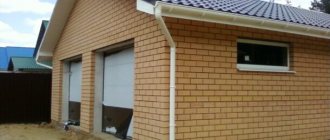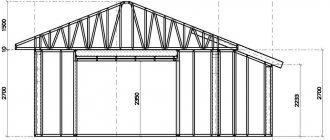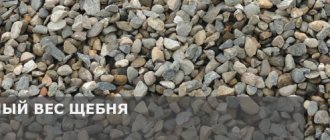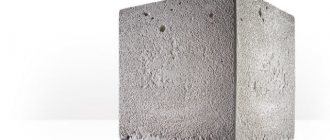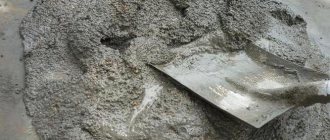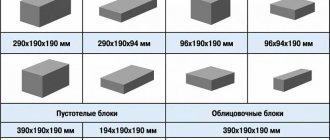A shell garage is a profitable solution for storing a car in congested cities. The article will discuss its features, advantages and disadvantages, what types there are. The main characteristics of a product of this type for storing a passenger car will be described.
Garage shell Source www.avtoprin.ru
How much does a reinforced concrete garage weigh without a floor?
Along with prefabricated metal analogues, the most popular type of garages are prefabricated reinforced concrete garages .
They have undoubted advantages, such as strength, durability, reliability (qualities characteristic of all reinforced concrete products, due to the original technical properties of the material), as well as relatively low cost, ease of assembly and operation, the possibility of simple dismantling and moving the structure to any other place, no need for welding work, except in the case of welding embedded parts of panels together. Thanks to the changes for the better that have occurred in the field of reinforced concrete products, all the components of garages are produced in factories, but not on construction sites, as was the case before, which makes it possible to reduce the cost of concrete garages by almost half, and transfer them from the category of elite to the category of relatively public ones garage structures. The convenience of assembling reinforced concrete garages is determined by the principle of an elementary “constructor”; all components are made with the expectation of maximum ease of installation, which, in some cases, allows you to do without the help of a specialized team. These items include the plates, hardware, and iron gates that are originally included with the prefabricated garage from the factory, along with detailed installation instructions. The standard list of garage elements is as follows:
1. Basement panels (if a basement is provided) 2. Two floor panels - left and right 3. Wall panels 4. Middle wall panel 5. Gate panel 6. Roof slab (hollow-core) 7. Metal brackets for assembly 8. Metal gate
Prefabricated reinforced concrete garages are unpretentious, but, nevertheless, they have some operational features and require periodic restoration. In particular, attention should be paid to the roof decking and wall treatment. When laying, the roof must be dry and clean, unevenness must be eliminated using cement mortar, after which roofing material and glassy plastic are glued. The roof of a concrete garage is not intended for walking; it is permissible if you first lay wooden boards on the roof. It is best to treat the walls from the inside with a solution of lime and whitewash; for the outside, simple cement plaster is quite suitable, which should be updated once every two to three years. The waterproofness of the garage will depend on the quality of the sealing of the joints of the wall panels; they are sealed with a concrete solution in a ratio of 1:2, the connecting brackets are carefully walled up. The drainage of sedimentary water will be carried out due to the trapezoidal shape of the side panels of the walls, forming a slope of three degrees.
The price of prefabricated reinforced concrete garages varies depending on the included equipment and dimensions. At the moment, the price of such a garage is higher than some of its analogues, but it fully meets all the advantages of a reinforced concrete structure and is in complete harmony with its functional characteristics.
Source
Features of gate selection
The garage door is the element with which the car owner has the greatest contact. They need to be opened and closed every time, and to ensure that the process does not test your nerves, you need to install gates with high-quality parts. A concrete garage can be equipped with the following types of gates:
- swing;
- sectional;
- lift-and-swivel;
- sliding gates;
The choice depends on the financial capabilities of the car owner. For example, sliding gates are very convenient to use. More expensive models are equipped with a remote roller system and the owner just needs to press a button and the section rises and lowers itself.
Reinforced concrete prefabricated and monolithic garages
An insulated reinforced concrete garage will be a good shelter for a car of any brand. It is more economical in construction, more reliable and durable than analogues made from other materials. It’s not difficult to build such a structure yourself, but it’s easier and faster to purchase a ready-made factory one. It can be easily repaired if the need arises.
Types and features
There are two types of garages on the market: prefabricated reinforced concrete and monolithic. The latter are more reliable, but before purchasing them be sure to take into account:
To avoid these difficulties in construction and operation, a prefabricated reinforced concrete garage is purchased. Manufacturers offer: hollow roof slabs, front gate panels, as well as elements for walls and floors. They are equipped with metal gates and brackets for assembly. If necessary, complemented with basement and middle wall panels. Thus, it is easy to choose the best option and install a garage from ready-made reinforced concrete structures with your own hands. For some, a significant benefit of this choice will be the reduction in final construction costs.
Regardless of the type, the garage, subject to technological standards and operating rules, is reliable and durable. Its other advantages include:
The main disadvantage is the relatively high cost of transporting a monolithic garage or composite parts to the installation site. Also, they require additional waterproofing of the roof and finishing, insulation of the walls, in order to avoid the formation of condensation. Some owners note poor ventilation and a typical, monotonous appearance.
Monoliths are made from cast concrete grade M300 with standard dimensions of 2.40x5.48x2.32 m, with a gate opening of 1.935x2.8 m. Wall thickness varies from 80–120 mm (the latter value corresponds to the thickness of the rib). Prefabricated elements are offered in a wide range of sizes. You can buy reinforced concrete panels for the construction of a garage for one car, 5.5–6 m long, 4 to 3.2 m wide, 2.32 or 2.6 m high. If necessary, a prefabricated structure for two cars, with dimensions 4x9 m, can be purchased Also, garages are installed in blocks - one, consisting of 12 boxes, is located on an area of 15x20 m.
The price of reinforced concrete modular garages depends on their size, configuration and manufacturer:
| Equipment, G – garage, P – floor, V – gate | Weight, t | Dimensions, m | Prices, rubles | ||
| Length | Width | Height | |||
| Perovsky reinforced concrete plant | |||||
| G + P + V | 14,7 | 6,0 | 3,2 | 2,6 | 186 880 |
| G + V | 10,23 | 5,48 | 3,24 | 2,32 | 116 180 |
| Concrete goods 15 | |||||
| G + P + V | 17,7 | 6,0 | 3,9 | 2,6 | 225 000 |
| 15,7 | 6,0 | 3,42 | 2,6 | 205 000 | |
| G + V | 10,23 | 5,48 | 3,24 | 2,32 | 160 000 |
| Concrete goods 18 | |||||
| G + P + V | 14,7 | 6,0 | 3,2 | 2,6 | 199 970 |
| 17,7 | 6,0 | 3,9 | 2,6 | 243 200 | |
| G + V | 10,23 | 5,48 | 3,24 | 2,32 | 124 310 |
| Concrete goods 9 | |||||
| G + P + V | 17,7 | 6,0 | 3,9 | 2,6 | 225 000 |
| 15,7 | 6,0 | 3,24 | 2,6 | 205 000 | |
General information
Varieties
A built-in garage can only be built during the construction of a house and have a separate entrance to it. An attachment can be made to an already constructed building or next to it. The collapsible structure can be installed anywhere.
According to the standard design, the shell garage is a multilayer semicircular shell made of two large metal profile sheets with the absence of any corners, which allows significant space saving. The stronger the metal, the more reliable your building will naturally be.
In addition to metal, the shell can be constructed from polymer plastic, a lightweight, bendable and very durable raw material. The garage can also be made of cast reinforced concrete sections, metal profiles and fiberglass.
Now the most common material for such a structure is considered to be galvanized corrugated sheeting, which is thinner than its previous counterpart, but has increased rigidity. And thanks to the wavy structure, the building becomes more reliable in strong gusts of wind and snow.
As for the sizes, it will depend on the dimensions of your car. So, for example, for a class B sedan car, the garage will have the following dimensions: length 6 m, width 3 m. Such a building is quite enough to drive a car into it.
There may be different variations of gate opening - in the form of regular leaves or roller shutter extension to the top. Moreover, the last solution is the most convenient and widespread. They can be lowered manually or automatically.
Advantages and disadvantages
A shell garage has the following advantages:
- The structure can be installed on almost any surface;
- In comparison with permanent buildings, such a garage will weigh relatively little, which will make it possible to construct it without the use of special machinery;
- Easy installation and dismantling;
- The small size will allow you to have a personal parking space that will protect your car from precipitation and thieves;
- Such a garage can be attached to the house, which will save even more space;
- Despite its simplicity, the garage is quite durable;
- Thanks to modern polymer materials, such a garage will not rust;
- Low cost.
The disadvantages include the following:
- Lack of comfort, because this is just an awning, in which there is no light and heat, as well as shelves for tools, like in a regular garage;
- In winter it will be cold, but in hot weather it will be very hot;
- Unpresentable appearance, especially if it is installed on a personal plot and does not harmonize with the overall appearance of the house and site;
- In a big city, if such a building is erected without permission in the courtyard of an apartment building, it can simply be demolished, since it cannot be called a full-fledged tent and residents can write a complaint;
- The lock, as a rule, is placed at the junction of the two halves, which is not very reliable against those who want to illegally get inside. Therefore, here you will need a non-standard approach to locking the shell.
All about a reinforced concrete garage: the pros and cons of building from slabs and concrete blocks, size, weight, photos
Today almost every family has a car; it has become an indispensable assistant in the city and in the country. Going for groceries or transporting seedlings by car is faster and more convenient.
But upon arrival at their site, many are faced with the problem of parking a car .
By leaving a car on the street, in the morning the car owner runs the risk of finding his car in a different condition than he left it in the evening. Yes, and sheltering from bad weather and repairing your “iron horse” is often useful. Therefore, many car owners are thinking about arranging a garage in their country house.
Today, the market offers prefabricated reinforced concrete structures made of concrete blocks and panels with floors.
Alternative solutions
Structures made from metal profiles have a lot of advantages, but some are not satisfied with their weight, problems with transportation when they need to move often, and some other nuances, so alternative solutions are selected. If you have to move often or go on vacation, then you can use a shell awning.
Shell awning Source bhutanmusktravels.com
Essentially, this is the same garage, but instead of sheets of metal, it uses high-strength fabric. It does not allow precipitation, wind or sunlight to pass through. In some cases, a tarpaulin is used for this, but it is better to use polyester fabric, which must be impregnated with special compounds. In addition, such an awning can be a good option for temporary housing on vacation, at the cottage, and so on.
Reinforced concrete garage: pros and cons
The advantages of prefabricated reinforced concrete garages include:
Having bought a garage made of reinforced concrete products , it will only take a few hours to assemble it; from reinforced concrete slabs - several days. If you need to move it to a new location, there will be no difficulties with this - the garage can be easily dismantled and is ready for assembly.
reinforced concrete factories supply a huge number of wall panels with gate openings, gates, floor slabs, entrances to the inspection pit and cellar.
Such garages can be built in any configuration and size, carrying out your own design in accordance with your operating requirements.
Flaws:
In this regard, during the construction process, proper organization of transportation and storage of slabs and concrete blocks .
Reinforced concrete garage - photo:
Video description
In the video you can see a prefabricated garage, which is easy to transport and quick to install:
To speed up the assembly of the pencil case shell garage, you can order the production of individual sections in advance. Pre-prepared holes for fasteners will also speed up the assembly process. All parts must be cleaned and polished. The frame must be coated with a special anti-corrosion agent. This will allow you to avoid serious problems during the operation of the structure in the future. Then everything can be painted. It is advisable to carry out preventive maintenance and treatment of metal structural elements once a year.
Metal elements must be coated with a special anti-corrosion agent Source market.sakh.com
Where is it smart to build?
The rules for the construction of objects of this class are specified in the documents: SNiP 30-02-97 and SP 30-102-99 .
The standards indicate that the design of the construction of garages on the ground and basement floors, incl. and attached ones are allowed without complying with the standards.
SNIP only regulates that outbuildings must be located one meter from the boundaries of the site and the distance between neighboring buildings with combustible floors must be at least 10 meters .
If a country house is being built, then a reinforced concrete garage built under the house has noticeable advantages:
If you choose a garage as an extension , then, of course, the main issue will be its reliability, functionality and convenience; in other words, price-quality.
With reliability, everything is clear - the stronger the garage, the better. But its construction will cost quite a significant amount. Purchase, delivery, invitation of workers. On the other hand, reliability and durability .
If you are planning to live in a country house or in a garden, then building a reinforced concrete garage is a justified decision. But to complete the documents you will still have to stand in line, which can take more than one month.
If you need a place to store garden tools, installing a small shelving will solve the problem. An inspection hole is also not required, this is an additional saving, since it will not require the cost of waterproofing.
If a dacha or garden is not a place of permanent residence, but only a personal plot with a holiday home, then this option is optimal due to its cost-effectiveness .
Factories of reinforced concrete products produce various versions of garages in size and weight, depending on the model. The weight of a reinforced concrete garage ranges between 10 and 17 tons . The kit includes a concrete floor and a gate.
Reinforced concrete garage size:
Design elements
GOST standards regulate not only the length, width and height of the cabin itself. Various types of structural elements are also standard for such structures. Thus, typical window sizes are 0.8 x 0.9, 7 x 7 m or 0.8 x 1 m. Standard door sizes for single-size change houses are 1800 x 800 m. The area of rooms in such structures is 6 m2 equal to 2.25 x 2.3 mm. The vestibule in single-size ones is most often made wide at 1.5 meters. In conventional designs, this figure can be equal to 1 meter. Construction cabins with one door and no windows are quite popular.
Article on the topic: The lights turned off in the garage, what to do?
Construction
The important point here is the choice of location and project . If previously prefabricated garages made of reinforced concrete were built on site - the foundation was poured, reinforcement was knitted, formwork was made, concrete was poured and everything was thoroughly compacted, then the labor intensity, time and price of such a garage was quite high.
Modern technologies have become noticeably simpler. Purchasing a prefabricated structure from a precast concrete reduces costs by about half. This concrete slab garage is designed for simple assembly and comes with detailed instructions. Even the garage owners themselves can assemble it without the help of builders.
Assembly steps:
The work will require lifting mechanisms . The slabs are fastened with anchor bolts and brackets. To install the gate, you will need a welding machine. The advantage is that there is no need for finishing work inside and outside the garage.
To insulate a collapsible concrete garage, foam . This allows you to do without internal heating.
The polystyrene foam is attached with mortar to the outer walls of the garage; plastic dowels are also used to secure it.
Afterwards, a network of plaster is applied, embedded in glue, which is applied to the foam.
At the final stage, the surface is coated with putty and, if necessary, paint is applied.
Waterproofing is used for any garage foundations. It is installed at a height of 15-25 cm from ground level to prevent moisture from penetrating into the walls.
Waterproofing is divided into horizontal and vertical.
The horizontal one is made using roofing felt , glued to heated bitumen in 2 layers. It is used in garages without basements, it is done around the entire perimeter of the garage along the foundation edge (its upper edge), but above ground level (required).
If the garage has a basement, in addition to the main one, protection against capillary moisture is used. For this purpose, vertical waterproofing is used at the level of the bottom of the foundation under the external walls. It is also installed on the outer edges of the outer walls of the basement. For these purposes, the edges are leveled with cement and bitumen.
If the ground water is above the basement floor, the basement should be protected with a closed shell made continuously.
The basement floor on top of the waterproofing is made of cement or concrete.
Cellar waterproofing is made from bioresistant coatings and waterproof impregnations.
The wood is impregnated 2-3 times with heated mixtures at intervals of 24 hours. After drying, the wood can be painted. Wood can be painted with oil paints; paints with rubber are also good; they can be used to paint any surface.
An inspection pit is not recommended in a garage, since due to temperature changes, condensation occurs in it, which causes corrosion of the vehicle.
Foundation thickness
The thickness of the reinforced concrete slab for the garage is chosen taking into account two main parameters:
- soil type;
- design weight of the building.
If the soil is unstable and has a significant freezing depth, then a foundation pit is excavated at a depth of 0.6–1.0 m for the power structure.
In order for the foundation to rest on a stable soil foundation, a compacted layer of medium sand is placed at the bottom of the excavation (layer height is 0.2–0.3 m).
In addition to the geological features of the site, the weight of the structure itself is of decisive importance. For example, for a one-story floor made of lightweight materials such as foam blocks, a monolithic slab height of 10 cm with one layer of reinforcement is sufficient. If the developer is designing a two-story structure, or a garage made of brick or concrete, then the thickness of the slab must be increased by 5 cm.
In practice, the thickness of the slab for a garage is taken to be somewhat higher than the recommended values. This choice is due to several reasons:
- so that during the cold season ice and snow do not interfere with the use of swing doors;
- so that storm water and rainwater do not enter the premises;
- to ensure normal use of the garage even in unforeseen situations, for example, if part of the foundation subsides, or the soil in front of the entrance rises as a result of heaving forces.
Finishing outside and inside
Flat roofs are covered with roofing felt, fiberglass or euro-slate. It is cheap, simple, easy to do and these materials protect well from water. But they become unusable after 5-10 years and have low resistance to damage.
Pitched roofs are covered with galvanized sheets, metal tiles, corrugated sheets or slate. The materials do not deteriorate for quite a long time, are durable and retain heat well, are resistant to temperature changes and are also fire resistant. Their disadvantage is their higher price and they are difficult to install.
If the garage is used in winter and heated, its roof must be insulated .
Wall finishing:
Finishing of modern prefabricated reinforced concrete garages is carried out either with cement plaster or decorating materials, such as block house, siding, artificial stone.
The ceiling is waterproofed with special compounds for this work (for example, Gidrotex-U), used to seal seams, joints and cracks. Afterwards, fiberglass tape is applied to problem areas, and a primer from a penetrating solution is applied to the entire ceiling. Next, finishing .
Three rules of work:
Based on these parameters, recommendations may be as follows: plastering surfaces, finishing with PVC, siding (metal) or panels (plastic), finishing with ceramic tiles, finishing with chipboard, OSB (boards) or lining (wood).
In conclusion:
Concrete garages are simple and reliable, they are durable and also warmer than their brick counterparts. Their disadvantage may be some uniformity and a higher price. They also have a price advantage over monolithic concrete ones. And if the financial issue is not a priority when building a car home, a garage made of concrete blocks will last you a very long time .
Source
How much does a reinforced concrete garage weigh?
Every car owner must ensure that his iron horse has a “home.” One possible option could be a reinforced concrete garage. This is a reliable and durable structure that will protect the car from any weather adversity. It is much more reliable than brick and iron. But previously, concrete structures had their drawbacks.
The construction of such a structure was expensive and labor-intensive, since all elements of the structure were manufactured on site. It was necessary to: pour the foundation, tie the reinforcement, set the formwork, fill everything with concrete and compact it thoroughly. And the cost of such a building was significantly higher than that of its analogues. And many simply couldn’t afford it.
Now the technology has become much simpler. Part of the structure is produced in factories and sold as prefabricated elements (based on the principle of a designer). This helped reduce costs by 50%. A concrete garage has become much more accessible and is gaining popularity among car owners. A prefabricated reinforced concrete garage is a construction kit for adult men that can be assembled without much difficulty, without the help of construction crews. The designers focused specifically on ease and simplicity of assembly.
Construction technology
The designers of such garages provide detailed instructions that clearly indicate the sequence of actions that must be followed. Let's consider the procedure based on the reinforced concrete products garage-2. Stages:
Lifting devices will be required to install all components. Installing the gate will also require welding work. The advantage is that you no longer have to resort to welding work. The building slabs are fastened together using anchor bolts and brackets. Another advantage is that a garage of this type does not require interior or exterior finishing work. It is able to function immediately after assembly. Weather conditions will not have a detrimental effect on the strength of a reinforced concrete garage, unlike an iron one. The second requires painting to avoid metal corrosion.
But still, after a long period of time, the garage begins to wear out. The concrete will begin to crack, and particles of the reinforcing mesh will be visible in the cracks. In order to prevent the garage from further deteriorating, the fittings should be cleaned of rust (using a jet of water under pressure), coated with an anti-corrosion agent, and the cracks sealed with a special putty.
To save on heating costs, you can insulate your garage. Foam is most often used. It is attached to the outer walls of the garage using a special solution, additionally secured with plastic dowels. Afterwards, a plaster network is applied, which is embedded in the glue applied to the foam. At the end of the work, the surface is covered with putty and painted (optional).
Summarizing
A concrete garage has a number of advantages over brick and iron. It is more reliable, easier to assemble, much warmer and more durable. Of course, such designs also have their drawbacks. They are much more expensive and look the same. There are two types of such garages: prefabricated and monolithic garages. The first has a number of advantages that make it more popular than a monolithic reinforced concrete garage. It is easier to assemble and is much cheaper.
If the question is about building a “home” for your car, and the financial issue is not a priority, then you shouldn’t even think about which one is better. The answer is obvious. Reinforced concrete structures will last a long time and flawlessly.
A metal garage is a reliable structure that protects your car from bad weather and thieves. It is easy to build, it is inexpensive and, if necessary, the box can be transported to another place without disassembling it. However, moving a metal garage requires knowing its weight so you can choose the right crane and van without overpaying. Let's figure out how much a finished metal garage weighs, and what methods of calculation exist.
Why do you need to know the mass of a metal garage?
Information about the weight of a metal garage is required by owners in the following cases:
To lift and transport it, you need to know the initial weight in order to correctly order loading equipment, the rental price of which varies greatly depending on the power. The situation is complicated by the fact that most of the buildings, dismantled or welded, are made by the owners themselves, and no preliminary calculation of their mass was made. In this case, you need to calculate the weight yourself.
You need to know the weight to order a vehicle with adequate power to deliver the cargo to the place. The foundation for a building is also poured to accommodate a certain load, and if done incorrectly, the reliability of the structure will be significantly reduced. Calculating the mass in such cases is not particularly difficult, since:
Note! The standard size is considered to be a structure 3 meters wide and 6 meters long. The height of the walls is 2 meters, the total height of the structure is 2.6 meters.
Assembly
Before building the “pencil case,” make a drawing, or use a ready-made one, copying it from the website of one of the many manufacturing companies. For a passenger car, a size of 3x6 or 4x6 meters, with a height of 2.5 meters, is suitable. Be sure to consider the slope of the roof in such a garage so that precipitation does not linger and spoil the roofing material. According to experts, a roof of this design can easily withstand a load of 100-150 kg per 1 square meter. m (in simple terms, 2 meters of snow will not become a hindrance on your roof, and it will not bend), so snow and other vagaries of nature are not scary for the pencil case.
The garage structure is made of galvanized corrugated sheets. This material has anti-corrosion treatment and is therefore resistant to external influences.
Please note that the thickness of the zinc oxide in the coating can be increased, first or second class, respectively; the use of sheets of a higher class will increase the service life of your garage
The seams of the structure are welded, treated with an anti-corrosion compound and coated with special enamel. The walls and roof can be covered with corrugated sheets. Garage doors are made using swing or lifting technology.
How to calculate weight yourself
Calculation of the final mass of a metal garage, the dimensions of which are 3x6 meters, is carried out according to the following algorithm:
Now it is necessary to determine the thickness of the metal with which the frame was lined. Most structures are made from sheets of metal, the thickness of which is 4 millimeters. One square meter of such cladding weighs 31.4 kilograms. Now we can calculate the total weight of the material used to cover the frame: 31.5 x 105 = 3,292 kilograms.
The frame of the structure, together with the gate, weighs about 1 ton. We add up the resulting numbers and get a final value of 4.3 tons. The values may vary up or down, depending on the thickness of the gate leaves and the material from which the frame was made.
Calculation formulas
| Determination of the theoretical mass of one linear meter of pipe |
m=?*(ds)*s*?/1000 , where
m=theoretical mass of one linear meter of pipe in kg, ?=3.14 (constant value), d=outer diameter in mm, s=wall thickness in mm, n=1000/m, ?=density in g/cm3
| Determining the approximate number of linear meters of pipe in one ton |
n=1000/m
| Determining the approximate amount of sheet in one ton |
| n=10/V*? |
| Determination of the theoretical mass of one sheet |
| m=V*?/10 , where |
m=theoretical weight of one sheet in kg, V=Sheet volume=thickness (mm)*, width (mm)*, length (mm), ?=density in g/cm3
| Determination of the theoretical mass of one linear meter of a circle |
m=x*d2*?/4000 , where
m=theoretical mass of 1 p/m of circle in kg,
x=3.14 (constant value),
d=outer diameter in mm,
p=density in g/cm3,
Density is taken in g/cubic meter. cm:
Formula for calculating the weight of 1 p/m of pipe. When you need to quickly find out how much a linear meter of a carbon steel pipe weighs, but there is no reference table, use this formula - Mp = ((Dn - Ts) / 40.5) * Ts Du - pipe diameter (mm), Ts - wall thickness ( mm), MP – weight of 1 p/m of pipe in kg.
Where would it be reasonable to put it?
On a private plot outside the city, you can easily install such a garage without unnecessary complications. But this will be justified if you live in the country for a long time.
In this case, a prefabricated metal garage or even a very modestly priced tent garage would be more suitable.
The things you store in the garage will always be within easy reach. In fact, in addition to the car, you will place a utility unit directly in the house.
Construction technology
According to the instructions, you need to assemble all the panels, securing them using the supplied components, these are brackets made of very durable metal, bolts, nuts, etc.
Before starting work, be sure to make sure that the manufacturer has packaged everything and sent it to you according to all items on the list attached to the product. Precast concrete garages are usually equipped with metal gates .
Foundation, pit/cellar construction
Since reinforced concrete structures tend to accumulate condensation, it is not worth making a cellar , as this will increase the already excessive humidity in the room.
Roof
A lightweight single slab with voids in the body is used as a roof.
You can sheathe and insulate it if you plan to have a heated garage. Otherwise, the lining makes no sense. You can make a metal pitched roof superstructure to reduce the retention of precipitation on the surface, which increases condensation in the room.
Panel assembly
If a basement is provided, then a queue is arranged first, at the very first stage.
Waterproofing
The floor and walls are completely waterproofed along the contour in the form of a strip of about 30 cm, starting from the very bottom of the walls. Waterproofing is applied by pouring concrete on the floor .
It is equally important to waterproof the ceiling using Hydrotex-U. Fiberglass is applied to more vulnerable areas and where the seams of the structure lie; it is sold in the form of tape and glued to a special compound.
Insulation
Foam sheets are the most common insulation for reinforced concrete buildings..
Watch the video about insulating a garage with foam sheets:
A flat roof is finished on the outside with roofing felt material , or in the case of a pitched roof, ondulin or corrugated sheeting is used.
If desired, the roof can be insulated from the inside in the same way as the walls.


